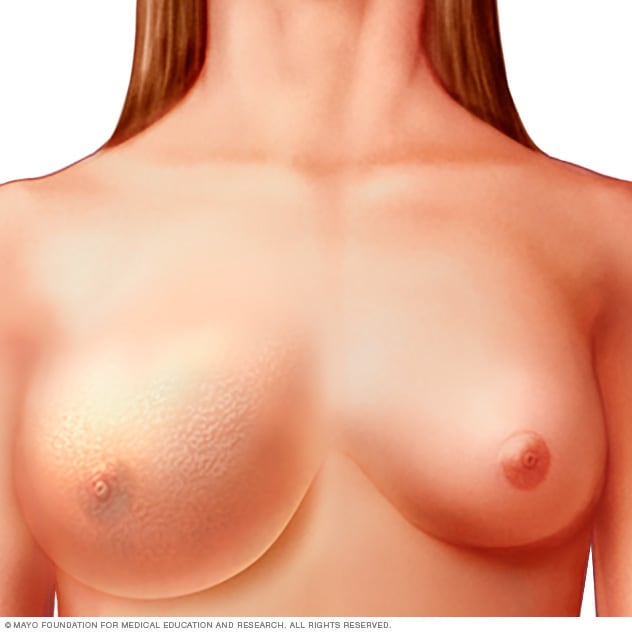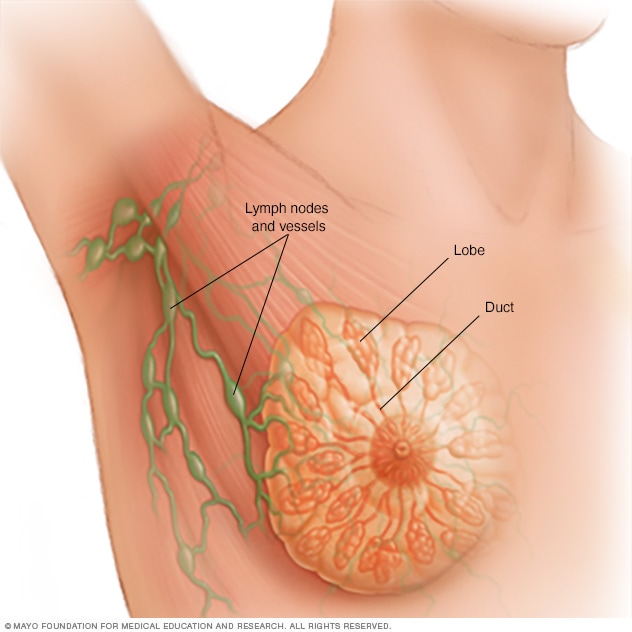概述
炎性乳腺癌

炎性乳腺癌
炎性乳腺癌常表现为乳房增大、皮肤变厚。皮肤可能呈红色、紫色或淤青。
炎性乳腺癌是一种导致乳房肿胀和皮肤变化的乳腺癌。
炎性乳腺癌发生在乳腺组织中形成一种细胞生长物时。细胞从最开始生长处脱落,进入皮肤的淋巴管。细胞可能阻塞血管,导致乳房皮肤看起来肿胀。乳房皮肤可能呈红色或紫色。
炎性乳腺癌被视为局部晚期癌症。如果癌症被归为局部晚期,表示它已经从起源位置扩散到附近的组织,并有可能已经扩散到附近的淋巴结。
炎性乳腺癌很容易与乳房感染相混淆,后者是导致乳房肿胀和皮肤变化的一个远为常见的原因。如果发现乳房皮肤有变化,请立即就医。
症状
炎性乳腺癌通常不会像其他形式的乳腺癌那样形成肿块。而是包括以下体征和症状:
- 一侧乳房的外观在几周时间内快速发生变化。
- 一侧乳房变厚、变重或肿胀。
- 肤色改变,导致乳房看上去是红色、紫色、粉色或淤青。
- 受累乳房异常发热。
- 受累乳房的皮肤出现像橘皮一样的凹陷或皱褶。
- 触痛、疼痛或酸痛。
- 腋下、锁骨上方或锁骨下方的淋巴结肿大。
- 受累乳房上的乳头变平或乳头内转。
要确诊为炎性乳腺癌,这些症状必须是在未满六个月内出现。
何时就医
如果出现任何令人担忧的症状,请与医生或其他医疗护理专业人员约诊。
其他更常见的状况也有类似于炎性乳腺癌的症状。乳房损伤或乳房感染(称为乳腺炎)可能导致皮肤变色、肿胀和疼痛。
炎性乳腺癌很容易与乳房感染相混淆,后者更为常见。最初用抗生素治疗一周或更长时间是合理的,也是常见的治疗方案。如果抗生素对您的症状有效,则无需进行额外的检查。但是,如果状况没有改善,医疗护理专业人员可能考虑您的症状是由更严重的病因引起的,例如炎性乳腺癌。
如果您接受过乳房感染治疗,但症状持续存在,请联系医疗护理专业人员。您可能需要进行乳腺 X 线摄影或其他检查来评估您的症状。医疗护理专业人员可以确定您的症状是否由炎性乳腺癌引起的唯一方法是取出组织样本进行检测。
病因
乳房解剖结构

乳房解剖结构
每侧乳房都有 15-20 个腺叶,排列的方式像雏菊的花瓣。腺叶还可以再分为更小的腺小叶,腺小叶可产生母乳喂养所需的乳汁。小乳管(称为乳导管)将乳汁运送至乳头下方的储乳器。
炎性乳腺癌发生在乳腺细胞的 DNA 出现变化时。细胞 DNA 含有指示细胞活动的指令。在健康细胞中,DNA 指令让细胞按设定速度生长和增殖。这些指令会指示细胞在设定的时间死亡。而在癌细胞中,DNA 的变化给出了不同的指令。这些变化会指示癌细胞快速产生更多细胞。在健康细胞应该死亡时,癌细胞仍继续存活。这会导致细胞过多。
乳房中的导管将母乳输送至乳头,DNA 的变化大多出现在其中一条导管中。但是癌症也可能始于可产生母乳的腺组织(称为小叶)细胞。
在炎性乳腺癌中,癌细胞从开始的地方分离出来,进入乳房皮肤的淋巴管。细胞会生长并堵塞血管。淋巴管阻塞会导致皮肤颜色变化、肿胀和皮肤凹陷。这种皮肤是炎性乳腺癌的典型体征。
风险因素
导致患炎性乳腺癌风险增加的因素包括:
女性
与男性相比,女性患乳腺癌(包括炎性乳腺癌)的可能性要大得多。每个人出生时都有一些乳腺组织,所以任何人都可能患乳腺癌。
年轻化
四五十岁的人更容易被诊断出炎性乳腺癌。
黑人
黑人比白人患炎性乳腺癌的风险更高。
肥胖
肥胖患者患炎性乳腺癌的风险增加。
预防
改变生活习惯可能有助于降低患乳腺癌的风险。请尝试:
咨询有关乳腺癌筛查的事宜
与医生或其他医疗护理专业人员讨论何时开始进行乳腺癌筛查。询问筛查有哪些益处和风险。与医生一起,您可以决定哪些乳腺癌筛查检测适合您。
通过乳房自检熟悉自己的乳房并提高乳房健康意识
您可以偶尔进行乳房自检来熟悉自己的乳房,并提高乳房健康意识。如果发现乳房有新的变化、肿块或其他异常迹象,请立即告知医疗护理专业人员。
乳房健康意识无法预防乳腺癌。但可能有助您更好地了解自己乳房的外观和感觉。这可能会让您更容易发现乳房的变化。
如果饮酒,适量即止。
如果您选择饮酒,请限制饮酒量,每天不要超过一杯。从预防乳腺癌的角度来说,没有安全的饮酒量。因此,如果您非常担忧患乳腺癌的风险,可以选择不饮酒。
每周多日进行锻炼
在一周的大多数日子里,争取每天至少运动 30 分钟。如果您最近没有怎么运动,请询问医疗护理专业人员是否可以运动,并慢慢开始。
在绝经期限制激素治疗
联合激素治疗可能增加患乳腺癌的风险。向医疗护理专业人员咨询激素治疗的益处和风险。
有些人在绝经期间会出现导致不适的症状。这些人可能愿意为了缓解不适而接受激素治疗的风险。为了降低患乳腺癌的风险,应在最短时间内使用尽量低剂量的激素治疗。
保持健康体重
如果您体重健康,请继续保持。如果您需要减重,请咨询医疗护理专业人员健康的减重方式。减少热量的摄入,并慢慢增加运动量。
Jan. 10, 2025